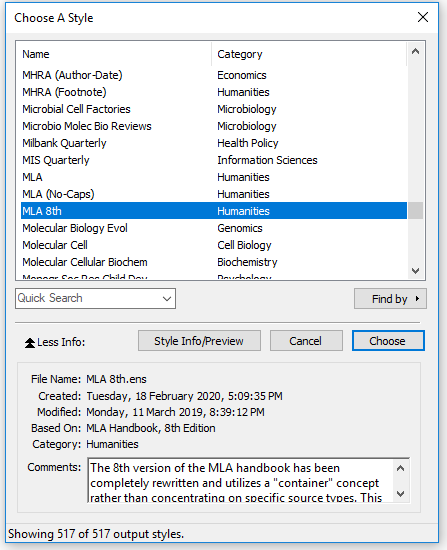EndNote referencing software: Step 3: Checking Styles & References
If you have trouble with creating an Endnote library and adding a reference reach out for help via our AskUWA contact email.
EndNote Learning Steps
Step 4: Importing references
Step 4a: Importing from OneSearch
Step 4b: Importing from a Database
Step 6: Using Endnote with MS Word
Step 6a: Adding references in Word
Step 6b: Editing references in Word
Optional Learning Path Steps
Organising your references
Choosing a reference style
UWA uses six main referencing styles and you will need to make sure the correct one has been selected. Check with your lecturer or supervisor about which style you should use for your documents.
- Near the top of the EndNote window is a drop-down menu of styles which is initially set to ANNOTATED. Click on the arrow and then click on SELECT ANOTHER STYLE. The CHOOSE A STYLE window will open.
- Highlight the style you are required to use eg MLA and click CHOOSE. This style will now appear in the style window.
Note: Search alphabetically by style name or use the "Quick Search"

Note: Mac users will find their STYLE MENU at the bottom of the RH Reference panel, as per the image in Changing your Layout

Notes:
- If you are publishing, you may need to check the journal editorial policy about which style you should use.
- A large number of styles are pre-loaded with your EndNote software, see "Download a Style" for how to load in additional styles.
- To select multiple frequently used styles go to EDIT>OUTPUT STYLES>OPEN STYLE MANAGER and check the boxes for these.
Preview a reference in the Style
Endnote allows you to preview how your reference will output in the particular style you have chosen. It's a good way to check if you have all the correct reference elements included in the reference record and help you identify any corrections needed.
- First making sure you have selected the correct referencing style, highlight a specific reference in your library - by selecting it with your cursor.
- The REFERENCE PANEL will display the selected reference. Select the PREVIEW tab to see a reference in the selected style (see above).
- Check the reference preview against a similar format type in our UWA specific referencing style guides.
- To make any required corrections go to the REFERENCE tab or double click on the reference to open it and make the necessary changes to the relevant fields.

Correcting a Reference based on the Style
A reference is made up of key elements with some additional requirements based on the type of format and where the reference comes from - with different requirements for online and/or print items. Our Referencing Style Guide provides examples of these and links to further information.
| Example of MLA referencing guidelines for a journal article format |
 |
To check if a reference is correctly outputting in Endnote - Activity
1. Preview the reference and compare it to a similar format example within the referencing style type you will be using.
2. Note any missing elements of the reference you are comparing to and go to the original source if required to find the missing details
3. Open up the reference in Endnote (by double-clicking on it) and find the relevant field that has the missing details.
4. Make the correction and check the preview of the reference to make sure it is now formatting correctly.
- Previewing the manual reference you created and comparing it to an online electronic article, what is missing?

- Find the missing field in the Endnote record for that reference, in this case, the DOI is missing.
- Add the missing element needed to complete your reference.
- Close the reference to save the change.
- Check your preview of the reference to check it now looks correct.

Note:
- Most styles will require the use of DOI if there is one, over a web address or database name.
- Some styles require the DOI needs to be preceded by "http://" - check the format examples for details
- If the reference you have changed has already been used in a Word document - make sure you use "Update Citations and Bibliography" option within your MS Word Endnote tab.



